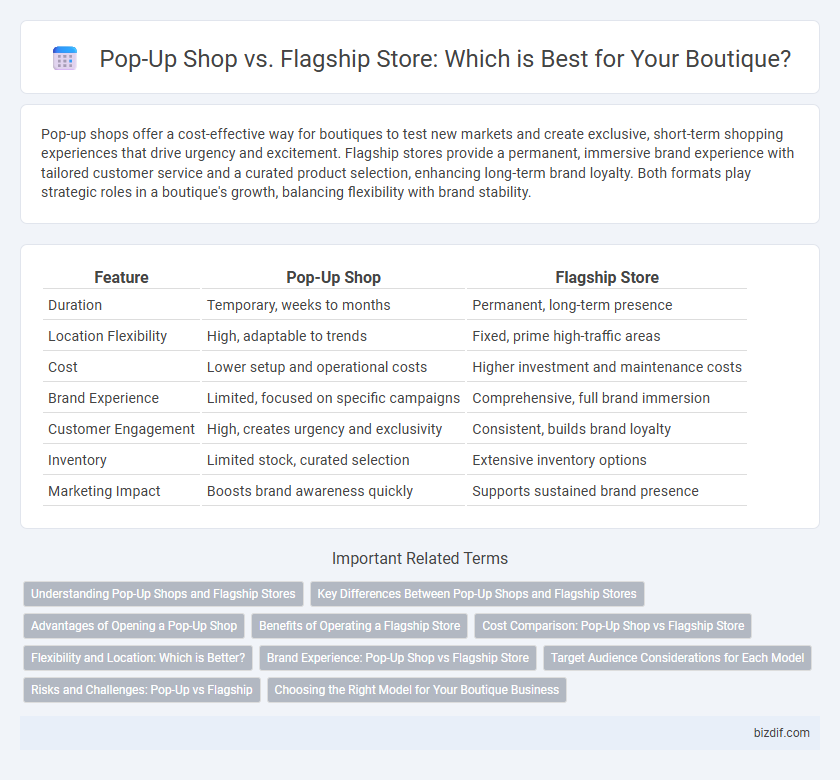Pop-up shops offer a cost-effective way for boutiques to test new markets and create exclusive, short-term shopping experiences that drive urgency and excitement. Flagship stores provide a permanent, immersive brand experience with tailored customer service and a curated product selection, enhancing long-term brand loyalty. Both formats play strategic roles in a boutique's growth, balancing flexibility with brand stability.
Table of Comparison
| Feature | Pop-Up Shop | Flagship Store |
|---|---|---|
| Duration | Temporary, weeks to months | Permanent, long-term presence |
| Location Flexibility | High, adaptable to trends | Fixed, prime high-traffic areas |
| Cost | Lower setup and operational costs | Higher investment and maintenance costs |
| Brand Experience | Limited, focused on specific campaigns | Comprehensive, full brand immersion |
| Customer Engagement | High, creates urgency and exclusivity | Consistent, builds brand loyalty |
| Inventory | Limited stock, curated selection | Extensive inventory options |
| Marketing Impact | Boosts brand awareness quickly | Supports sustained brand presence |
Understanding Pop-Up Shops and Flagship Stores
Pop-up shops are temporary retail spaces designed to create buzz and test new markets, offering unique, limited-time experiences that drive customer engagement. Flagship stores serve as permanent, brand-defining locations showcasing the full product range and embodying the brand's identity in prime retail spaces. Both concepts play strategic roles in boutique retail, with pop-ups emphasizing agility and experimentation, while flagship stores focus on brand prestige and customer loyalty.
Key Differences Between Pop-Up Shops and Flagship Stores
Pop-up shops offer temporary, flexible retail spaces designed to create buzz and test markets, while flagship stores serve as permanent, brand-defining locations that showcase the full product range and brand identity. Pop-up shops typically operate with lower investment and limited inventory, focusing on exclusivity and experiential marketing, whereas flagship stores require substantial capital and emphasize immersive, comprehensive brand experiences. The key differences lie in duration, cost, product assortment, and strategic role within a brand's retail ecosystem.
Advantages of Opening a Pop-Up Shop
Opening a pop-up shop offers boutiques a flexible and cost-effective way to test new markets without the long-term commitments of a flagship store. These temporary retail spaces generate excitement and urgency, driving higher customer engagement and increased brand visibility. Pop-up shops also allow for rapid feedback collection and product experimentation, enabling boutiques to adapt quickly to consumer preferences and trends.
Benefits of Operating a Flagship Store
Operating a flagship store offers unparalleled brand visibility and creates a powerful customer experience through immersive, curated environments that reflect the boutique's identity. Flagship stores serve as strategic retail hubs, attracting high foot traffic and enabling direct interaction with customers to build loyalty and gather valuable feedback. The physical presence of a flagship store enhances brand credibility and supports long-term growth by showcasing exclusive collections and hosting events.
Cost Comparison: Pop-Up Shop vs Flagship Store
Pop-up shops offer a cost-effective alternative to flagship stores by significantly reducing expenses related to long-term leases, build-out costs, and ongoing utilities. Flagship stores require substantial upfront investment in prime retail locations, extensive interior design, and permanent staffing, leading to higher fixed operational costs. The flexible and temporary nature of pop-up shops enables brands to test markets with minimal financial risk and lower overhead compared to the comprehensive commitments of flagship storefronts.
Flexibility and Location: Which is Better?
Pop-up shops offer unmatched flexibility, allowing boutiques to test multiple locations with minimal commitment and respond quickly to market trends. Flagship stores provide a stable, permanent presence that strengthens brand identity and builds customer loyalty in a strategic location. For boutiques prioritizing adaptability and cost-efficiency, pop-up shops are ideal, while flagship stores excel in establishing long-term brand authority.
Brand Experience: Pop-Up Shop vs Flagship Store
Pop-up shops create a dynamic brand experience by offering limited-time, immersive environments that foster exclusivity and direct customer engagement. Flagship stores provide a comprehensive, permanent brand presence with curated displays and extensive product offerings, reinforcing brand identity and consumer loyalty. Both formats enhance brand experience through distinct, strategic touchpoints tailored to different consumer interactions.
Target Audience Considerations for Each Model
Pop-up shops effectively target trend-driven, impulse buyers by offering limited-time exclusivity and localized experiences, ideal for testing markets or seasonal promotions. Flagship stores cater to brand loyalists and high-value customers seeking immersive, comprehensive brand engagement through extensive product displays and personalized services. Understanding the demographic preferences and shopping behaviors of the target audience ensures the optimal choice between the dynamic, flexible pop-up model and the stable, experience-rich flagship format.
Risks and Challenges: Pop-Up vs Flagship
Pop-up shops face risks such as limited customer reach, short-term engagement, and higher initial setup costs per visit compared to flagship stores. Flagship stores confront challenges including high overhead expenses, long-term financial commitment, and complex inventory management. Both models require strategic planning to balance brand exposure with operational efficiency and customer experience.
Choosing the Right Model for Your Boutique Business
Selecting the right model between a pop-up shop and a flagship store depends on your boutique's target market, budget, and growth strategy. Pop-up shops offer a cost-effective, flexible way to test new locations and create urgency through limited-time experiences, while flagship stores establish a permanent brand presence providing comprehensive customer engagement and inventory. Analyzing customer demographics, sales goals, and long-term brand vision helps determine whether a short-term pop-up or a full-scale flagship store better aligns with your boutique's success.
Pop-Up Shop vs Flagship Store Infographic

 bizdif.com
bizdif.com